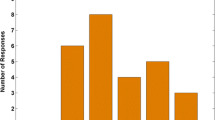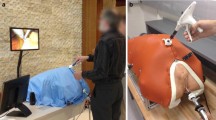Abstract
Introduction and study aim
Natural orifice translumenal endoscopic surgery (NOTES) is an emerging surgical technique that requires a cautious adoption approach to ensure patient safety. High-fidelity virtual-reality-based simulators allow development of new surgical procedures and tools and train medical personnel without risk to human patients. As part of a project funded by the National Institutes of Health, we are developing the virtual transluminal endoscopic surgery trainer (VTEST™) for this purpose. The objective of this study is to conduct a structured needs analysis to identify the design parameters for such a virtual-reality-based simulator for NOTES.
Methods
A 30-point questionnaire was distributed at the 2011 National Orifice Surgery Consortium for Assessment and Research meeting to obtain responses from experts. Ordinal logistic regression and the Wilcoxon rank-sum test were used for analysis.
Results
A total of 22 NOTES experts participated in the study. Cholecystectomy (CE, 68 %) followed by appendectomy (AE, 63 %) (CE vs AE, p = 0.0521) was selected as the first choice for simulation. Flexible (FL, 47 %) and hybrid (HY, 47 %) approaches were equally favorable compared with rigid (RI, 6 %) with p < 0.001 for both FL versus RI and HY versus RI. The transvaginal approach was preferred 3 to 1 to the transgastric. Most participants preferred two-channel (2C) scopes (65 %) compared with single (1C) or three (3C) or more channels with p < 0.001 for both 2C versus 1C and 2C versus 3C. The importance of force feedback and the utility of a virtual NOTES simulator in training and testing new tools for NOTES were rated very high by the participants.
Conclusion
Our study reinforces the importance of developing a virtual NOTES simulator and clearly presents expert preferences. The results of this analysis will direct our initial development of the VTEST™ platform.











Similar content being viewed by others
References
Kalloo AN, Singh VK, Jagannath SB, Niiyama H, Hill SL, Vaughn CA et al (2004) Flexible transgastric peritoneoscopy: a novel approach to diagnostic and therapeutic interventions in the peritoneal cavity. Gastrointest Endosc 60(1):114–117 PubMed PMID: 1525
Moris DN, Bramis KJ, Mantonakis EI, Papalampros EL, Petrou AS, Papalampros AE (2012) Surgery via natural orifices in human beings: yesterday, today, tomorrow. Am J Surg 204(1):93–102 PubMed PMID: 1509
Huang C (2011) Natural orifice transluminal endoscopic surgery: new minimally invasive surgery come of age. World J Gastroenterol 17(39):4382 PubMed PMID: 1546
Rattner D, Kalloo A (2006) ASGE/SAGES working group on natural orifice translumenal endoscopic surgery, October 2005. Surg Endosc 20(2):329–333 PubMed PMID: 1222
Auyang ED, Santos BF, Enter DH, Hungness ES, Soper NJ (2011) Natural orifice translumenal endoscopic surgery (NOTES(®)): a technical review. Surg Endosc 25(10):3135–3148 PubMed PMID: 1512
Chukwumah C, Zorron R, Marks JM, Ponsky JL (2010) Current status of natural orifice translumenal endoscopic surgery (NOTES). Curr Probl Surg 47(8):630–668 PubMed PMID: 58
Coomber RS, Sodergren MH, Clark J, Teare J, Yang G-Z, Darzi A (2012) Natural orifice translumenal endoscopic surgery applications in clinical practice. World J Gastrointest Endosc 4(3):65–74 PubMed PMID: 1507
Targarona EM, Maldonado EM, Marzol JA, Marinello F (2010) Natural orifice transluminal endoscopic surgery: the transvaginal route moving forward from cholecystectomy. World J Gastrointest Endosc 2(6):179–186 PubMed PMID: 1518
Dallemagne B, Marescaux J (2010) NOTES: past, present and future. Asian J Endosc Surg 3(3):115–121 PubMed PMID: 1529
Dehn T, Austin RCT (2009) Natural orifice translumenal endoscopic surgery (NOTES)-scar free or scary? Ann R Coll Surg Engl 91(3):192–194 PubMed PMID: 1533
Rattner DW (2008) NOTES SAJCo. NOTES: where have we been and where are we going? Surg Endosc 22(5):1143–1145 PubMed PMID: 1062
Fiolka A, Gillen S, Meining A, Feussner H (2010) ELITE-the ex vivo training unit for NOTES: development and validation. Minim Invasive Ther Allied Technol 19(5):281–286. doi:10.3109/13645706.2010.510673
Gillen S, Wilhelm D, Meining A, Fiolka A, Doundoulakis E, Schneider A et al (2009) The “ELITE” model: construct validation of a new training system for natural orifice transluminal endoscopic surgery (NOTES). Endoscopy 41(5):395–399 PubMed PMID: 1297
Gillen S, Fiolka A, Kranzfelder M, Wolf P, Feith M, Schneider A et al (2011) Training of a standardized natural orifice transluminal endoscopic surgery cholecystectomy using an ex vivo training unit. Endoscopy 43(10):876–881 PubMed PMID: 1536
Gromski MA, Alkhoury F, Lee S-H, Matthes K (2010) Evaluation of NOTES hands-on courses by surgeons at the SAGES Annual Meeting Learning Center. Surg Endosc 24:229
Tsuda S, Matthes K, Hill CS, Derevianko A, Derevianko T, Moshin A et al (2010) Validation of a high-fidelity NOTES simulator for team training. World Congress of Endoscopic Surgery/SAGES Annual Meeting, Landover
Tsuda S, Scott D, Doyle J, Jones DB (2009) Surgical skills training and simulation. Curr Probl Surg 46(4):271–370 PubMed PMID: 164
Fried GM (2008) FLS assessment of competency using simulated laparoscopic tasks. J Gastrointest Surg 12(2):210–212 PubMed PMID: 1497
Soper NJ, Fried GM (2008) The fundamentals of laparoscopic surgery: its time has come. Bull Am Coll Surg 93(9):30–32
Vassiliou MC, Dunkin BJ, Marks JM, Fried GM (2010) FLS and FES: comprehensive models of training and assessment. Surg Clin North Am 90(3):535–558 PubMed PMID: 1527
Vassiliou MC, McKenna DT, Kaneva PA, Park P-O, Swain P, Rothstein RI (2009) Development of an assessment tool to measure technical skills for NOTES®. Gastrointest Endosc 69(5):AB306 PubMed PMID: 1542
Duffy AJ, Hogle NJ, McCarthy H, Lew JI, Egan A, Christos P et al (2004) Construct validity for the LAPSIM laparoscopic surgical simulator. Surg Endosc 19(3):401–405 PubMed PMID: 217
Sankaranarayanan G, Adair JD, Halic T, Gromski MA, Lu Z, Ahn W et al (2010) Validation of a novel laparoscopic adjustable gastric band simulator. Surg Endosc 25(4):1012–1018 PubMed PMID: 1543
Matthes K, Sankaranarayanan G, Ahn W, De S (2012) Simulator-based training of NOTES procedures. In: Kalloo AN, Marescaux J, Zorron R (eds) Natural orifice translumenal endoscopic surgery: textbook and video atlas. Wiley-Blackwell, Chichester, pp 291–307
Thompson CC, Ryou M, Soper NJ, Hungess ES, Rothstein RI, Swanstrom LL (2009) Evaluation of a manually driven, multitasking platform for complex endoluminal and natural orifice transluminal endoscopic surgery applications (with video). Gastrointest Endosc 70(1):121–125 PubMed PMID: 1534
Acknowledgments
This work was supported by NIBIB/NIH Grant #R01EB009362.
Disclosures
Dr. Kai Matthes: Endosim, LLC (ownership), Ovesco Endoscopy USA Inc. (consultation, equipment support), Olympus America Inc. (equipment support). Arun Nemani and Drs. Ganesh Sankaranarayanan, Woojin Ahn, Masayuki Kato, Daniel B. Jones, Steven Schwaitzberg, and Suvranu De have no conflicts of interest or financial ties to disclose.
Author information
Authors and Affiliations
Corresponding author
Additional information
Presented as a poster at the SAGES 2011 Conference.
Rights and permissions
About this article
Cite this article
Sankaranarayanan, G., Matthes, K., Nemani, A. et al. Needs analysis for developing a virtual-reality NOTES simulator. Surg Endosc 27, 1607–1616 (2013). https://doi.org/10.1007/s00464-012-2637-1
Received:
Accepted:
Published:
Issue Date:
DOI: https://doi.org/10.1007/s00464-012-2637-1




